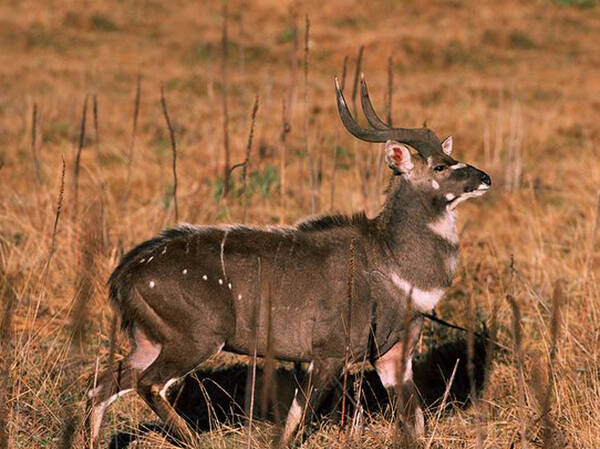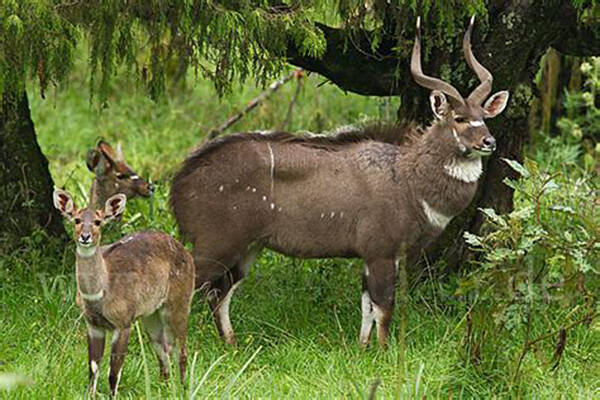Tragelaphus buxtoni
IUCN
LCBasic Information
Scientific classification
- name:Tragelaphus buxtoni
- Scientific Name:Tragelaphus buxtoni,mountain antelope, mountain antelope, alpine antelope, mountain antelope
- Outline:Ungulata
- Family:Artiodactyla Bovidae Sapir
Vital signs
- length:190-260cm
- Weight:150-320kg
- lifetime:About 19 years
Feature
White patch between eyes, two white spots on cheeks, white spots on sides and rump
Distribution and Habitat
The mountain bushbuck is endemic to the Ethiopian highlands southeast of the Great Rift Valley. The species has disappeared from much of its former range and is found primarily in the Bale Mountains National Park, with smaller, scattered populations in the Bale, Arse, and Cherry Mountains.
It inhabits high-altitude woodlands, grasslands, scrub, heaths, and Afro-alpine swamps at elevations of 3,000-4,300 m, but has been recorded as low as 1,600 m. The species has been forced into higher areas by modern agriculture and livestock grazing.
Appearance
The mountain nyala is 190-260 cm long, 90-135 cm tall at the shoulder, and 20-25 cm long tail; it weighs 150-320 kg. The fur is gray-brown to chestnut-brown with a white patch between the eyes, two white spots on the cheeks, two white spots on the throat and chest, white spots on the sides and rump, and up to nine unclear white stripes. The fur on the underparts is slightly darker, with dark legs with white spots on the inside, and the tail is bushier with white on the base. The pattern is unique to each species. The fur is smooth and shiny in summer and becomes more moist in the winter months.
Males are larger than females and have long spiral horns that can reach 118 cm in length. Males have darker fur than females, with a tuft of dark hair on the neck and a brown and white mane on the back that extends from the neck to the base of the tail. The mountain nyala is similar to the larger takin.
Details
Mountain Nyala (scientific name: Tragelaphus buxtoni) is called Mountain Nyala in foreign language, and has no subspecies.

Mountain Nyala is most active in the evening and early morning, collecting grass leaves, ferns, aquatic plants and lichens for food. In cold or hot weather, they often hide in dense woods such as woods and heather. The mimicry of fur markings may help hide the animal's form and also play a role in social communication. During display, the white dorsal crest of the male will stand up, and the white fur on the inside of the tail will repeatedly appear and disappear during the run.
Mountain antelopes generally move alone or in small, loose groups. The average group has about 8-9 females and subadults, and occasionally large groups of up to 96 can gather. The group structure may change with the season. Young males will join bachelor groups, while older males are usually single. Mountain antelopes do not seem to be very territorial, but males will establish a dominance hierarchy.
Mountain bushbuck mating usually occurs during the dry season from December to January, and the female gives birth to a single calf after a gestation period of about 8-9 months, usually in the late rainy season from August to September. The calf's fur is light in color, darkening with age and densely covered in the weeks after birth. The lactation period lasts 3-4 months, and the calf remains with the female for up to two years.

The mountain antelope is protected by law, but enforcement is generally nonexistent. Effective protection is limited to about 20 square kilometers of habitat near the Gaysai Steppes and the Bale Mountains. The mountain antelope living in the Bale Mountains N.P. Harbor accounts for about half of the total. In 1990 the small Kuni-Muktar Game Reserve became a second protected area for the mountain antelope, but by 1996 this reserve had been severely impacted by poaching, logging, cultivation and gully erosion and the species no longer existed. An additional protected area was established in the Arsi Mountains in 2011 which may provide some conservation benefits for the species.
The mountain antelope is an important flagship species for the Bale Mountains along with the Ethiopian wolf. Its future will be closely linked to the future of this protected area. The survival risks of the mountain antelope will also be very important through the establishment of effective protection and management elsewhere in its range. Some sustainable reward hunting in these areas has very high potential to generate funds for the effective conservation of this species and other species in shared habitats. No mountain antelope are yet in captivity and it may be possible to establish a self-sustaining captive range in collaboration with conservation authorities in Ethiopia as insurance against future adversities caused by the species in the wild.
Listed in the 2016 Red List of Threatened Species of the World Conservation Union (IUCN) ver 3.1 - Endangered (EN).
Protect wild animals and eliminate game.
Maintaining ecological balance is everyone's responsibility!








